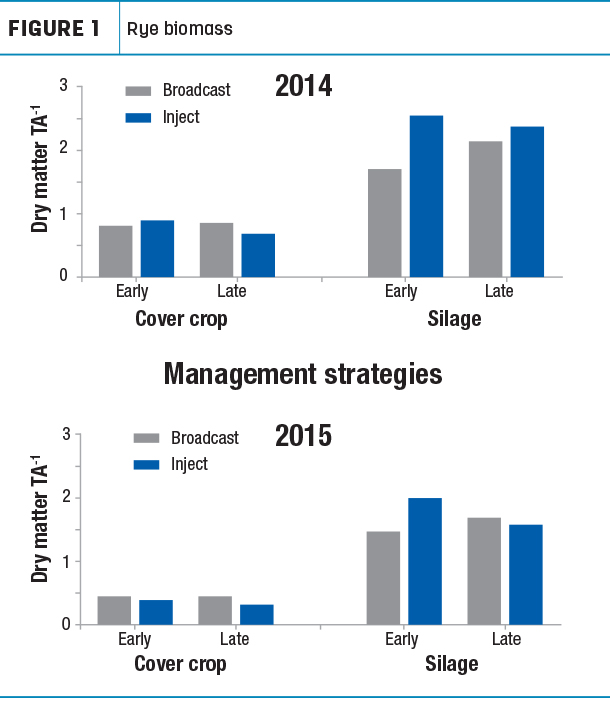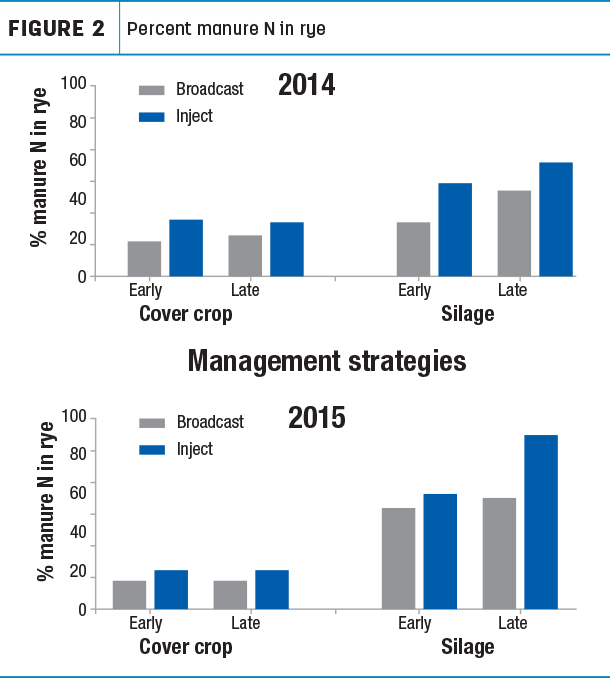Double-cropping can also increase total harvested forage, if winter annuals are managed as a crop, not just for cover.
Optimizing fall-applied manure-N
Winter annuals grown for silage can utilize manure nutrients and prevent loss of fall-applied manure nutrients to the environment. In a two-year study, we sought to quantify the potential for cereal rye to conserve nitrogen from fall-applied dairy manure. In central Pennsylvania, we compared rye grown longer for silage or terminated earlier as a cover crop, and liquid dairy slurry manure applied in early or late fall.
Liquid manure was shallow-disk injected or surface broadcasted without incorporation at a rate of 5,000 gallons per acre, either prior to planting the winter rye with a no-till drill in September or six to eight weeks after rye was planted, in November.
Over two years, ryelage was harvested 10 or 11 days after the cover crop was terminated and produced three to fourfold more forage (Figure 1), and contained 1.9 to 3.3-fold more fall-applied manure-N than the aboveground rye cover crop (ranging from 32 to 70 pounds per acre more nitrogen, see Figure 2).


Fall manure application strategies significantly impacted ryelage. With early fall applications, shallow-disc injected manure produced 42 percent more ryelage and contained an average of 57 percent more manure-N than ryelage that received broadcasted manure.
Due to poor rye germination in the second year, rye was replanted two weeks prior to November manure injection, resulting in an 11 percent loss of rye plants in the following spring and 22 percent yield reduction. Despite damage and reduced ryelage yield, ryelage following late fall manure applications contained more manure-N whether broadcasted or injected, and the combination of late manure application and injection resulted in the highest ryelage manure-N – from 60 to 91 percent over two years (Figure 2).
Similarly, following rye silage, the percentage of manure-N in the soil was 1.5- to 5.5-fold higher after late-injected manure than after late-broadcasted manure at various depths, and 1.8- to 3.4-fold higher with late-injected manure than early-injected. We did not apply any additional N for the subsequent corn crop, and manure injection resulted in 35 percent greater corn silage yields after all injected than broadcasted manure in the second year and 30 percent more corn after late-fall-injected than late-broadcasted manure in the first year.
In short, double crops in central Pennsylvania, with fall manure injection and late application, can increase total harvested forage and manure-N utilization compared to surface broadcasting and early manure application. Further, other studies have shown that planting a winter cereal as soon as possible following corn silage harvests can increase crop yield, as conditions for crop growth such as day length and temperature decline in autumn.
With greater manure-N conservation following late applications, producers can prioritize winter annual planting over manure applications, but avoid injecting after planting if the winter annual isn’t well established.
Additional fertilization
Since nutrient management is key for optimal forage production, one should account for nitrogen and potassium removal by both crops, and use soil tests to determine if additional potassium is needed for either crop.
Top-dressing in spring with manure or N fertilizer can also boost crop yield and quality. In another three-year study, we compared no-till rye silage when fall-applied manure was surface broadcasted and not incorporated, or injected, both at 4,500 gallons per acre. To increase ryelage yield and protein, we top-dressed 80 pounds of N per acre in the spring on the surface broadcast manure treatment, and 50 pounds of N per acre on the manure injection treatment due to greater N conservation.
Ryelage yields at 65 percent moisture content averaged 8.9 tons per acre and ranged from 7.2 and 10.8 tons per acre; crude protein ranged from 16.4 to 19.8 percent; and NDF ranged from 59 to 62 percent. Further, with 30 pounds of N per acre less top-dressed, the injected manure treatment produced similar yields to the broadcasted manure.
In addition, identifying which winter cereal species perform best given a farm’s soils, climate and management can make it easier to produce high-quality forage. Other points to keep in mind are:
- Consider planting two or more species such as winter rye, triticale and winter wheat to determine which species work well.
- Plan to harvest at flag leaf stage for high crude protein and digestibility.
- Watch weather forecasts and have equipment and personnel ready to take advantage of dry weather days to harvest.
- Planting more than one crop species can diversify the optimal days to harvest each species and provides some spring harvesting flexibility.
- Experienced small-grain silage producers recommend tedding the forage to dry it quickly for ensiling at the target moisture content for storage conditions (bunker silo, AgBag, etc.).
Timely spring harvest can be difficult in years with frequent rainfall. Delaying silage harvest can produce lower-quality feed for dry cows, heifers or beef cattle, and greater yield. Alternatively, consider terminating some fields as a cover crop to return nutrients and organic matter to the soil. If planting no-till, be prepared to:
- Plant into cover crop residue with row cleaners.
- Increase the subsequent crop seeding rate.
- Scout for possible early season pests such as armyworm and slugs.
Plant the subsequent crop soon after harvest, but with caution during wet weather conditions, as trips across the field to apply nutrients, mow, ted and harvest can compact soil. In the subsequent crop, assess if and how much sidedress N is needed by monitoring soil pre-sidedress soil nitrate test (PSNT) or plant N.
Species selection, nutrient amendments and attention to crop maturity need to be adapted for each farm and weather conditions, but double-cropping winter and summer annuals can produce quality forage and positive economic returns. ![]()
Dr. Heather Karsten is with the Pennsylvania State University Department of Plant Science. Email Heather Karsten.
Rachel Milliron is a field and forage crops educator with the Penn State Cooperative Extension.











